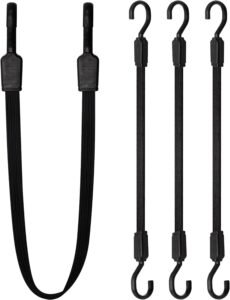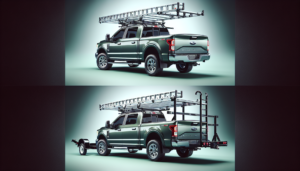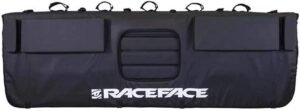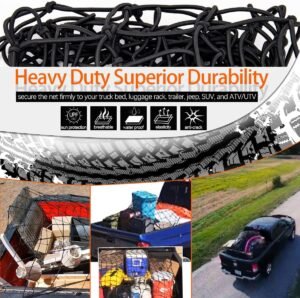
If you’re an outdoor enthusiast who loves kayaking or canoeing, you’ve probably wondered if there’s an alternative to bulkier roof racks for transporting your gear. Well, the good news is that using a ladder rack might just be the solution you’ve been looking for. With its sturdy construction and adjustable features, a ladder rack can easily be adapted to securely hold your kayaks or canoes during travel. So, before you invest in a dedicated roof rack, consider the versatility and convenience of using a ladder rack for your outdoor adventures.
Overview of ladder racks
What is a ladder rack?
A ladder rack is a device that is used to securely transport items such as ladders, kayaks, or canoes on the roof of a vehicle. It typically consists of a set of bars or rails that are mounted on the roof and provide a stable platform for carrying these long and bulky items.
Types of ladder racks
There are several types of ladder racks available on the market, each designed to accommodate different needs and vehicle types. The most common types include:
-
Crossbar ladder racks: These racks feature two parallel bars that run across the width of the roof. They are adjustable and can be mounted directly onto the roof or on existing roof rails.
-
Side-mounted ladder racks: These racks are mounted on the sides of the vehicle and are often used for larger or heavier items. They provide additional stability and are commonly used for commercial purposes.
-
Over-cab ladder racks: These racks extend over the cab of the vehicle, providing additional storage space. They are popular among contractors and individuals who need to transport longer items.
Benefits of using a ladder rack
Using a ladder rack offers numerous benefits, regardless of whether you are transporting ladders, kayaks, or canoes. Some of the key advantages include:
-
Increased cargo space: By utilizing the roof of your vehicle, a ladder rack allows you to transport large and bulky items without sacrificing interior space. This can be particularly useful when traveling with passengers or additional gear.
-
Improved safety: Ladder racks are designed to securely hold items in place, reducing the risk of them shifting or falling during transit. This helps to prevent accidents on the road and ensures the safety of both the driver and other motorists.
-
Easy access: With a ladder rack, you can easily load and unload your kayaks or canoes without straining your back or needing a second person to assist you. This convenience makes it simpler to embark on spontaneous outdoor adventures.
Considerations before using a ladder rack for kayaks or canoes
Before you decide to use a ladder rack for transporting your kayaks or canoes, there are several important factors to consider.
Weight capacity
One of the primary considerations when using a ladder rack for kayaks or canoes is the weight capacity of the rack. It is crucial to ensure that the rack is capable of safely supporting the combined weight of your watercraft and any additional equipment or accessories.
Compatibility
Not all ladder racks are created equal, and not all are suitable for transporting kayaks or canoes. It is essential to check the compatibility of the rack with your specific watercraft. Consider factors such as the width and length of your kayak or canoe, as well as the design of the rack, to ensure a proper fit.
Safety measures
Safety should always be a top priority when transporting kayaks or canoes on a ladder rack. Take the time to familiarize yourself with any safety guidelines provided by the rack manufacturer, and follow proper loading and securing procedures. Additionally, consider using additional safety measures such as bow and stern ties or straps to prevent any lateral movement during transit.
Stability
The stability of the ladder rack is crucial to ensure a safe and smooth journey. Before using the rack for kayaks or canoes, carefully inspect it for any signs of wear or damage. Make sure the rack is securely attached to the roof of your vehicle and check the tightness of all fasteners. A wobbly rack can compromise the safety of your watercraft and pose a risk to other drivers on the road.
Benefits of using a ladder rack for kayaks or canoes
Using a ladder rack specifically designed for kayaks or canoes offers several key benefits that make it the preferred choice for many outdoor enthusiasts.
Convenience
A ladder rack provides a convenient and hassle-free solution for transporting kayaks or canoes. It eliminates the need for cumbersome straps or ropes inside the vehicle and allows for quick and easy loading and unloading. With a ladder rack, you can focus on enjoying your outdoor adventure instead of struggling to secure your watercraft.
Accessibility
By using a ladder rack, you can easily access your kayaks or canoes whenever you want, without having to rearrange or remove other items from your vehicle. This allows for spontaneous trips to the water without any unnecessary preparation or inconvenience.
Versatility
Ladder racks designed for kayaks or canoes are typically adjustable and versatile. They can accommodate different sizes and types of watercraft, making them suitable for a wide range of kayaks or canoes. This versatility ensures that you can transport your watercraft securely, regardless of their specific dimensions or design.
Choosing the right ladder rack for kayaks or canoes
When it comes to selecting a ladder rack for kayaks or canoes, there are several key factors to consider. These factors will help ensure that the rack is compatible with your watercraft and meets your specific needs.
Rack compatibility with watercraft
Before purchasing a ladder rack, verify that it is compatible with your particular kayak or canoe. Consider the dimensions and weight of your watercraft, as well as any specific requirements or attachments it may have. Look for a rack that provides a secure and snug fit, minimizing the risk of damage during transportation.
Adjustability and versatility
Look for a ladder rack that offers adjustability and versatility. This will allow you to fine-tune the rack’s configuration to accommodate different kayaks or canoes. Consider racks that feature adjustable crossbars or cradles, as well as interchangeable components, as they offer the flexibility needed to transport multiple watercraft.
Installation process
Consider the installation process when choosing a ladder rack. Look for a rack that is easy to install and does not require any specialized tools or equipment. Quick and straightforward installation makes it more convenient to use the rack whenever needed, without wasting valuable time or energy.
Additional features
Some ladder racks may offer additional features that enhance their functionality and convenience. Look for racks that include features such as integrated locks for added security, padded surfaces to protect your watercraft, or built-in tie-down points for easy and secure attachment. These features can make a significant difference in the overall user experience.
Steps for securely transporting kayaks or canoes on a ladder rack
Once you have selected the appropriate ladder rack for your kayaks or canoes, follow these steps to securely transport them:
Gathering the necessary equipment
Before starting the loading process, gather all the necessary equipment. This usually includes straps or ropes, bow and stern ties, and any other securing devices recommended by the rack manufacturer. Ensure that everything is in good condition and free of any fraying or damage.
Preparing the kayak or canoe
Before placing your watercraft on the ladder rack, prepare it for transit. This typically involves removing any loose items such as seats or accessories, and securing the paddle alongside the kayak or canoe. It is also a good idea to clean the kayak or canoe beforehand to prevent debris from flying off during transport.
Loading the watercraft onto the rack
With the ladder rack properly installed and the kayak or canoe ready, carefully lift the watercraft onto the rack. Position it in the center, ensuring that it is balanced and stable. Make sure the kayak or canoe is not overhanging the sides of the vehicle or obstructing any windows or lights.
Securing the watercraft
Once the kayak or canoe is in position on the ladder rack, begin the securing process. Use the provided straps, ropes, or tie-downs to secure the watercraft to the rack. Start by securing the bow and stern to prevent any lateral movement, and then proceed to secure the body of the kayak or canoe to the rack. Ensure that all straps are tight and properly aligned to prevent shifting or loosening during transit.
Double-checking everything before driving
Before hitting the road, double-check all the connections and ensure that everything is properly secured. Give the kayak or canoe a gentle shake to confirm that it is stable and does not move excessively. Additionally, check the tightness of all straps or ropes and confirm that the ladder rack is securely attached to the roof of your vehicle. Taking these extra precautionary measures will help ensure a safe and worry-free journey.
Safety tips for transporting kayaks or canoes on a ladder rack
Transporting kayaks or canoes on a ladder rack requires careful attention to safety. Follow these tips to ensure a secure and accident-free journey.
Regularly check the rack’s stability
Before every trip, inspect the ladder rack for any signs of wear or damage. Check the tightness of all fasteners and make sure the rack is securely attached to your vehicle. Regularly maintaining the rack’s stability will minimize the risk of accidents or unexpected shifting during transit.
Properly secure the kayaks or canoes
Ensure that your watercraft is properly secured to the ladder rack at multiple points. Use appropriate tie-downs and straps, and make sure they are tightly secured and properly aligned. Avoid overtightening, as this can damage your watercraft, but ensure that there is no excessive play or movement.
Use additional tie-downs
In addition to the straps or tie-downs provided with the ladder rack, consider using additional tie-downs for added security. Bow and stern ties can help prevent lateral movement and stabilize the watercraft on the ladder rack. These additional tie-downs provide an extra layer of protection and peace of mind during transit.
Drive cautiously and within speed limits
When transporting kayaks or canoes on a ladder rack, it is essential to adjust your driving style accordingly. Be cautious, especially when turning or changing lanes, as the added height and weight of the watercraft can affect the vehicle’s handling. Adhere to the speed limits and follow all traffic regulations to ensure a safe journey for yourself and others on the road.
Alternative options for transporting kayaks or canoes
While ladder racks offer a convenient and practical solution for transporting kayaks or canoes, there are other alternatives to consider depending on your specific needs.
Roof racks
Roof racks are a popular alternative to ladder racks for transporting kayaks or canoes. They typically consist of two crossbars that are mounted directly onto the roof of the vehicle. Roof racks offer a stable and secure platform for carrying watercraft but may require additional attachments or cradles to properly accommodate kayaks or canoes.
Trailer hitch racks
If you prefer not to load your kayaks or canoes onto the roof of your vehicle, a trailer hitch rack may be a suitable option. These racks attach to the hitch receiver at the rear of your vehicle, providing a platform to transport your watercraft at ground level. Trailer hitch racks offer easy loading and unloading but may limit access to the rear of your vehicle.
Truck bed racks
For truck owners, truck bed racks can be an excellent option for transporting kayaks or canoes. These racks are installed in the bed of the truck and provide a secure and stable platform for carrying watercraft. Truck bed racks allow for easy loading and unloading and offer the advantage of keeping your watercraft protected from the elements.
Common mistakes to avoid when using a ladder rack for kayaks or canoes
When using a ladder rack for transporting kayaks or canoes, it is important to avoid these common mistakes that can compromise safety or damage your watercraft.
Overloading the rack
Always adhere to the weight capacity specified by the ladder rack manufacturer. Overloading the rack can cause structural damage, reduce stability, and increase the risk of accidents. Ensure that the combined weight of your watercraft, additional equipment, and any attached accessories fall within the recommended limits.
Insufficient securing of the watercraft
Properly securing your kayaks or canoes to the ladder rack is crucial to prevent shifting or damage during transit. Take the time to securely fasten all straps or tie-downs, ensuring that they are tight and aligned properly. Insufficient securing can result in unexpected movement, risking damage to your watercraft or even causing accidents on the road.
Failing to check the stability
Neglecting to regularly inspect the ladder rack for stability can lead to unforeseen problems during transit. Before each trip, carefully examine the rack for any signs of wear or damage. Check the tightness of all fasteners and verify that the rack is securely attached to your vehicle. This simple step can significantly reduce the risk of accidents or shifting while on the road.
Not following the manufacturer’s instructions
Every ladder rack is unique, and it is essential to follow the manufacturer’s instructions when installing and using the rack. Failure to do so may void any warranties and may compromise the safety and functionality of the rack. Always refer to the provided instructions and guidelines to ensure a safe and effective transport.
Conclusion
A ladder rack can be a valuable tool for transporting kayaks or canoes safely and conveniently. By choosing the right ladder rack, following proper installation and securing procedures, and adhering to safety guidelines, you can enjoy worry-free adventures with your watercraft. Remember to regularly check the stability of the rack, secure your kayaks or canoes properly, and drive cautiously when transporting them. If a ladder rack does not meet your needs, consider alternative options such as roof racks, trailer hitch racks, or truck bed racks. With the right equipment and a strong emphasis on safety, you can confidently transport your kayaks or canoes and embark on new outdoor experiences.





